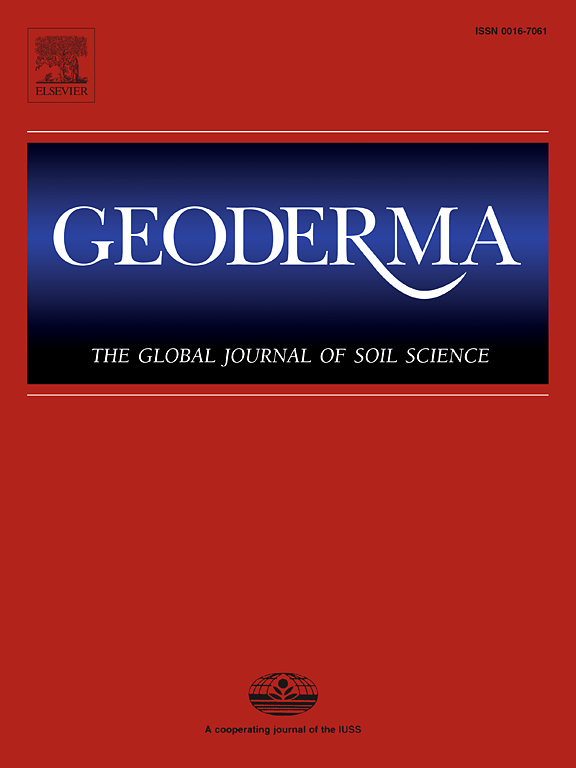Assessing the impact of recycled water reuse on infiltration and soil structure
IF 5.6
1区 农林科学
Q1 SOIL SCIENCE
引用次数: 0
Abstract
Soil sodicity, salinity, clay dispersion, and clay soil cracking are significant issues for modern agriculture, especially in arid and semi-arid regions of the world. Sodium adsorption ratio (SAR) has traditionally been used to estimate potential changes in infiltration rates or hydraulic conductivity when sodium cations dominate irrigation water quality. Recent research indicates that the cation ratio of soil structural stability (CROSSf and CROSSopt) provides better predictive capabilities for soil structure and threshold electrolyte concentration than SAR, especially when water used for irrigation or aquifer recharge contains both potassium and sodium cations. In this study, soil columns filled with clay loam were used to assess the impact of recycled water reuse on soil structure stability and saturated hydraulic conductivity. Ten treatments were prepared using chloride solutions of sodium, potassium, calcium, and/or magnesium to create a broad range of synthetic recycled water qualities with varying SAR, CROSSf, and CROSSopt values. After a pre-saturation process, the columns were maintained to have a constant 1 cm head of treatment solutions with a salinity of 1.5 dS/m. The results showed that CROSSf had a stronger correlation with saturated hydraulic conductivity and soil aggregate stability in comparison to CROSSopt and SAR. The R2 for saturated hydraulic conductivity and soil structure were 0.90 and 0.94 for CROSSf, 0.41 and 0.60 for CROSSopt, and 0.75 and 0.78 for SAR, respectively. Notably, the treatments that received solutions with 0-SAR values but contained potassium had significantly more dispersible clay throughout the entire soil column than the treatment that received calcium chloride solution. It was concluded that the CROSSf model could offer enhanced accuracy and insight into predicting the impact of recycled water reuse for irrigation on soil infiltration rate and soil aggregate stability.
评估循环水再利用对渗透和土壤结构的影响
土壤钠度、盐度、粘土分散和粘土开裂是现代农业面临的重大问题,尤其是在世界干旱和半干旱地区。钠吸附率(SAR)传统上用于估算钠阳离子主导灌溉水质时渗透率或水力传导性的潜在变化。最近的研究表明,与 SAR 相比,土壤结构稳定性的阳离子比率(CROSSf 和 CROSSopt)能更好地预测土壤结构和阈值电解质浓度,尤其是当灌溉用水或含水层补给水同时含有钾和钠离子时。在这项研究中,使用了填满粘壤土的土柱来评估循环水回用对土壤结构稳定性和饱和导水率的影响。使用钠、钾、钙和/或镁的氯化物溶液制备了十种处理方法,以形成具有不同 SAR 值、CROSSf 值和 CROSSopt 值的多种合成循环水水质。经过预饱和处理后,水柱中的处理溶液保持恒定的 1 厘米水头,盐度为 1.5 dS/m。结果表明,与 CROSSopt 和 SAR 相比,CROSSf 与饱和水力传导性和土壤集料稳定性的相关性更强。CROSSf 的饱和导水率和土壤结构的 R2 分别为 0.90 和 0.94,CROSSopt 为 0.41 和 0.60,SAR 为 0.75 和 0.78。值得注意的是,与接受氯化钙溶液的处理相比,接受 SAR 值为 0 但含有钾的溶液的处理在整个土壤柱中的可分散粘土含量要高得多。结论是,CROSSf 模型可以更准确、更深入地预测再生水回用于灌溉对土壤入渗率和土壤团聚稳定性的影响。
本文章由计算机程序翻译,如有差异,请以英文原文为准。
求助全文
约1分钟内获得全文
求助全文
来源期刊

Geoderma
农林科学-土壤科学
CiteScore
11.80
自引率
6.60%
发文量
597
审稿时长
58 days
期刊介绍:
Geoderma - the global journal of soil science - welcomes authors, readers and soil research from all parts of the world, encourages worldwide soil studies, and embraces all aspects of soil science and its associated pedagogy. The journal particularly welcomes interdisciplinary work focusing on dynamic soil processes and functions across space and time.
 求助内容:
求助内容: 应助结果提醒方式:
应助结果提醒方式:


